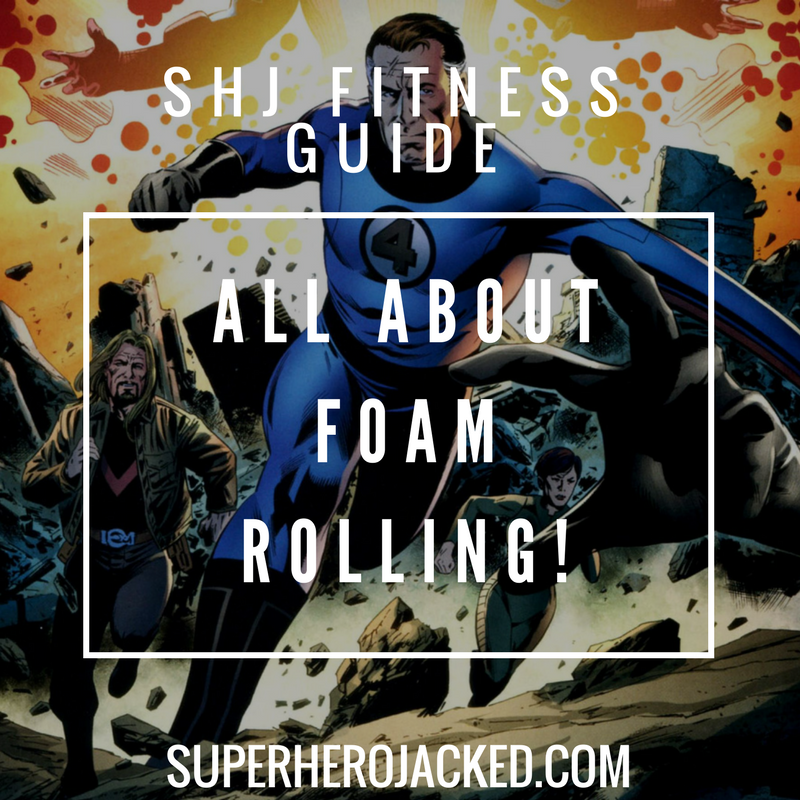 While the craze has been dying down just a little bit, it used to be that everyone and their mother was obsessed with the practice of rolling out- aka, foam rolling.
While the craze has been dying down just a little bit, it used to be that everyone and their mother was obsessed with the practice of rolling out- aka, foam rolling.
For those of you who aren’t sure what I’m talking about, foam rolling is the practice of self-myofascial release, similar to a deep tissue massage.
In theory, you can foam roll around a specific body part and break apart stiff muscles and become as flexible and mobile as Mr. Fantastic. Since it’s popularity reached a loud crescendo a few years ago, a lot of marketing, hyperbole, and enthusiasm has surrounded foam rolling.
But is there any truth to some of these claims? Is foam rolling just a product of broscience?
Let’s look into the facts, separate out some of the fiction, and weigh out the pros and cons into the practice.
Are you ready?
Well then stop, drop- and wait for me to say ‘roll out’.

Foam Rolling IS NOT A Cure-All!
I mentioned a certain buzz-term before called self-myofascial release. Without writing an eyesore of a post detailing the specifics, it’s essentially just another way of saying self-massage. In theory, foam rolling offers the same benefits of a regular deep tissue massage, all without working with a therapist and done at your own pace and leisure. You may have seen proponents boldly claiming that foam rolling can go so far as to break up scar tissue as well, practically rejuvenating your entire body.
I’m sorry to burst your bubble, but foam rolling actually doesn’t get rid of any knots or tightness in your muscles. At least, not in the way you think it does.
The tissues of our body are mostly made of collagen, which is capable of adapting to daily stress and physical activity. Therefore, if we’re physically active, the tissues will more or less adapt as a response to motion. On the flipside, if we’re inactive (like many deskbound, couch-warrior types in Western society), the tissues will start to head towards stiffness. Speaking of which, if you’ve ever taken a long road trip or become bed-bound from sickness, you’ve most likely felt this tight feeling all over your body once you start to get up and move around.
That’s due to inactivity. It’s not quite a ‘move it or lose it’ situation, but somewhere along those lines. Anyone who’s new to exercise may recall how stiff they felt at the beginning of working out, and how, over time, it started to go away the more consistent they became with their routine(s).
As for the aforementioned claim that it can break up scar tissue, I’m afraid that’s also a bold claim without any scientific grounding. The tissues in our body are not pillows that need a bit of fluffing and turning over. In fact, they’re quite strong, as is the collagen found within them. (Type 1 is actually stronger than steel, gram for gram, according to Molecular Cell Biology, 4th edition. [1]).
So, do you really think a simple roll around a foam tube or tennis ball is going to actually alter this tissue like a chunk of Play-Doh clay? How about- no?
There’s also another thing to factor in- the three main layers of your skin that cover these deep tissues. All of which are thick in their own right, and very hard to get through. Unless your name is Jason and you have a love for hockey masks and machetes, I don’t think anyone of us is going to be reaching that deep past these layers anytime soon.
So, as much as you and I would love to believe that self-myofascial release is going to literally restructure our deep tissues, it’s simply not a reality.

Foam Rolling Won’t Make You Uber Flexible
No, I am not speaking out against the use of foam rolling because I’m a yoga teacher in fear of getting replaced by an inanimate piece of foam. If truth be told, if a foam roller could actually make me insanely flexible, I could launch a career in Cirque Du Soleil in seconds flat. I’d bypass the usual hours of flexibility training and preparation and become the world’s most time-efficient contortionist. If this sounds too good to be true, then you, and I, are correct.
Flexibility is not an overnight phenomenon. And the foam roller is not a fairy godmother waving her magic wand and turning you into Elastic Girl. It requires consistency, awareness, and, most importantly, time. That’s another topic for another day, but the foam roller doesn’t work that way. Now, continuing on with the fairy godmother analogy, foam rolling does have a temporary effect towards flexibility. But it’s incredibly short.
In a 2008 study by Chaundry and colleagues, myofascial release (such as foam rolling) improved acute (short-term) flexibility lasting up to only ten minutes [2].
Now, the keyword here is improved. Not “enhanced” or “changed” one’s flexibility, just improved it. So, take it with a grain of salt. If a newbie to stretching tried foam rolling for the first time, they’d have a minor leg up in their current state of flexibility. And if Gumby came along and tried it, he’d probably just shrug it off and only become ever so slightly more flexibility, if that’s even possible. But again, the payoff is criminally poor.
However, here’s where it might come in handy.
Say you’re looking to deepen your squat at the gym. Hop on the nearest foam roller, and get to the rack as quickly as possible. If your form is right and you know what you’re doing, you may just hit that PR and improve your performance. No guarantees, but it’s something that may help you in the short term.

Foam Rolling Helps You to Become More Flexible
For many of us, supplements are just ‘boosts’ to an otherwise healthy diet and lifestyle. They can be fish oil capsules, amino acids, protein powders, or antioxidant powders. None of these are truly necessary; there’s no such thing as an ‘essential protein powder’ or ‘essential antioxidant-oil- complex’. We can survive just fine by keeping things simple, sticking to real food that doesn’t need a cartoon character or commercial to help advertise it. But thanks to modern technology and research, we do see the benefits of smart supplementation from food-based derivatives.
With flexibility, a foam roller serves as a functional supplement to cap off a good training protocol tailored to your specific goals and needs. You don’t have to join the foam-rolling craze and buy the most expensive device out there. You don’t have to devote so much time rolling out your muscles into oblivion. And you’re not missing out on becoming a circus performer by choosing not to foam roll either. It isn’t the by-all-end-all when it comes to flexibility.
But here’s how it does improve your training, should you decide to use it.
Foam rolling helps to relax your body, enabling you to ease into stretching. This is done by way of stimulating the parasympathetic nervous system. You want to be calm and relaxed, and that’s what happens when you enter a parasympathetic state of “rest and digest”. [3] When it comes to improving our flexibility, we want to avoid falling into a sympathetic, “fight or flight state”. That’s great if we’re performing high intensity interval training (HIIT) exercises, cardio, sports, or power lifting, but we don’t want our body to be a bundle of nerves when we’re trying to focus on cooling down and allowing our muscles to become soft and pliable.
By locking ourselves into a sympathetic state, our muscles lock up in anticipation, believing we’re still going after or being chased by a saber tooth tiger. We know that’s not going to happen, but our connective tissue doesn’t. Our muscles won’t allow us to bend and move with ease. We’ll only lock up and bend under the pressure of our own nerves, which a reason why many students (as well as teachers) end up injuring themselves during yoga. They either feel compelled to keep up with a fast-paced class or compete with the more experienced student beside them. All of that tension and stress pushes them past the edge of the stretch and into strain.
You don’t ever want to do that, believe me. I’ve seen it time and time again, and have gotten close to doing it myself a few times. (That’s how humility can actually save you!)
So here’s where foam rolling comes in.
According to physical therapist and CrossFit Games athlete Talayna Fortunato, “The latest theory is myofascial release is just a direct input to your central nervous system to tell these overactive muscle fibers to stop firing so much. So it’s almost something to help downregulate the system.” [5]
By stimulating the parasympathetic nervous system, foam rolling helps us to mentally and physically “chill out”. No, you’re not taking any “happy pills”, and I don’t think a tube of foam is going to replace a white, sandy beach, but it’s going to help prime you for entering recovery mode.
That’s why foam rolling is best for either after your workout or at the beginning of a recovery based exercise, such as yoga, Pilates, or mobility work.
It’s like a warm-up for your cool down.

Foam Rolling Helps in Recovery
Choosing to foam roll your muscles after exercises can help you to recover. Similar to its effects towards overall, sustained flexibility, foam rolling by itself isn’t going to magically restore the areas of your body you’ve just worked. But as a useful tool, or supplement to your recovery, it’s really quite useful.
Delayed Onset Muscle Soreness, otherwise known as DOMS, occurs within a few hours post workout to even a day after. Beginners are especially prone to DOMS, as their body hasn’t gotten used to working out at a particular intensity. DOMS doesn’t necessarily mean you’ve pushed yourself too hard (sometimes it does), but for those who are trying to adopt a more active lifestyle or are focusing on a particular goal, DOMS can make staying consistent a very daunting task. Why bother trying if it’s only going to hurt you in the end, right?
Well, aside from learning the right ways to recover, foam rolling can help to relieve DOMS in conjunction to your standard protocols, such as stretching, taking a mandatory rest day for those muscles to rebuild and recover, and doing light, easy-going activities such as walking.
Foam rolling assists in recovery and reducing DOMS due to three factors:
#1: Improving Blood Flow: The added pressure from foam rolling causes blood to be driven to the areas you choose to target, which also brings in more oxygen to help you recover. One of the worst things you can do after an intense workout is sit around all day and night and never engage in any more activity. Doing so can actually hinder your progress! Without the natural stimulation of blood flow from natural movement, your tissues start to stiffen up in an ischemic state (when blood supply is restricted).
#2: Aiding in Fluid Transport: Don’t worry; I’m not going to drop a science report on you! Here’s what I mean by fluid transport.
The applied pressure to the muscles you foam roll transfers fresh fluid and nutrients into them. [6] An added bonus to this process is a natural “flush” of cellular waste and byproducts through the lymphatic system, which doesn’t have a pump or lever we can pull in order to activate. Supporting it requires a simple prescription of gentle, methodical movement. This in and of itself is a natural rejuvenation process for your muscles, done without committing to any fad diets or pills.
All you’re doing is helping your body to perform an innate function.
You don’t give a baby robotic legs to make it walk. You take them by the hand and allow them to learn how to stand on two feet with your support. Foam rolling acts similarly; you’re just making the process a little bit easier, that’s all.
#3: Activating the Parasympathetic Nervous System: We already covered this today, but it bears repeating! Rolling out ushers in a wave of soothing support for your depleted muscles. What follows is the dissipation of tension, allowing you really hone in on relaxing and stretching safely.
So think about this- you’ll either have to take another off day before it’s time for you to workout again, or, you’ll be insufficiently prepared for the next workout. It’s just like missing out on sleep. A night or two of short sleep won’t kill you in the short term, but if it becomes habitual then your body will inevitably crash and burn. The same can be said for your muscles if you choose to ignore the importance of proper recovery.
In short, foam rolling is an excellent recovery tool to help you begin your next workout refreshed and restored, and ready to make new progress.

Putting Foam Rolling into Practice
Now that we know what foam rolling is, and what it is not, here’s how you can incorporate it into your training protocol. If you’re not able to access any of the tools I’ve listed below, don’t worry; foam rolling is just a supplement for recovery and flexibility training. It is no substitute, and you won’t be deprived of any progress should you decide not to do it.
Foam rolling tools include the Rumble Roller (which is made with “bumps” and indents), foam PVC pipes, tennis or lacrosse balls, or a standard, smooth foam roller. Many of these can be purchased online or in-person at sports and outdoor recreation stores, Target, Walmart, or even a gym (my local 24 Hour Fitness sells them near their front desk). Your gym may already provide a few foam rollers for use; so if you’d rather save some money and make the most of your membership, feel free to use one of those. An additional piece of advice would be to ask if one of their qualified trainers can show you how to use it if you’re new to foam rolling.
YouTube also has a few tutorials and routines for foam rolling as well; just be sure they’re made by certified trainers or physical therapists to ensure your safety!
I’ll paraphrase a formula from the National Academy of Sports Medicine (NASM) on how to foam roll, in case you’d rather do it yourself. [7]
- Search: Slowly use the foam roller to roll the length of the muscle of choice. Identify any tight or tender areas.
- Destroy: Hold onto the tender areas you’ve located for a few seconds. (Focus on breaking up any “stagnation” and imagine yourself “breathing” relief into them with your breath.)
- Mobilize: As you hold the tender spots, try moving differently than simply rolling up and down; side to side, bending and straightening if you’re working on your arms or legs, etc.
- Flush: Finish by slowly rolling the entire length of the muscle, end to end, without stopping.
My additional advice would be to follow up with light stretching or yoga to further encourage blood and lymphatic flow. Inversions in particular are excellent. Moving slowly from one pose to another also helps, too, such as transitioning from a runner’s stretch to a low lunge with your back knee softly placed on the mat.
Combining foam rolling with a good stretching or yoga routine is a one-two punch towards improving flexibility and supporting recovery from exercise! I myself can personally attest to the benefits of this approach, and have seen improvements not only in my own flexibility but also in my performance at the weight room.
Use this knowledge to your advantage heroes!
– Sam, aka, The Dragon
Join The Superhero Academy and start unleashing your inner SuperHuman.
References:
[1] https://www.ncbi.nlm.nih.gov/books/NBK21475/
[2] Chaundry, H., Schleip, R., Ji, Z., Bukiet, B., Maney, M., and Findley, T. (2008). Three-
dimensional mathematical model for deformation of human fasciae in manual therapy.
Journal of Amercian Osteopathic Association. 108, 379-390.
[3] https://www.sciencedaily.com/terms/parasympathetic_nervous_system.htm
[4] http://science.howstuffworks.com/life/inside-the-mind/emotions/fear2.htm
[5] https://barbend.com/foam-roller/
[6] Schleip, R., Duerselen, L., Vleeming, A., Naylor, I.L., Lehmann-Horn, Zorn, A., et al. (2012). Strain hardening of fascia: Static stretching of dense fibrous connective tissue can induce a temporary stiffness increase accompanied by enhanced matrix hydration. Journal of Bodywork & Movement Therapies, 16, 94-100
[7] http://blog.nasm.org/ces/foam-rolling-techniques-a-4-step-formula/

SUPERHUMAN SECRETS V.2
NOW UPDATED AND EXPANDED WITH A NEW SECTION & SEVEN BONUSES
USD$29 USD$14.95


